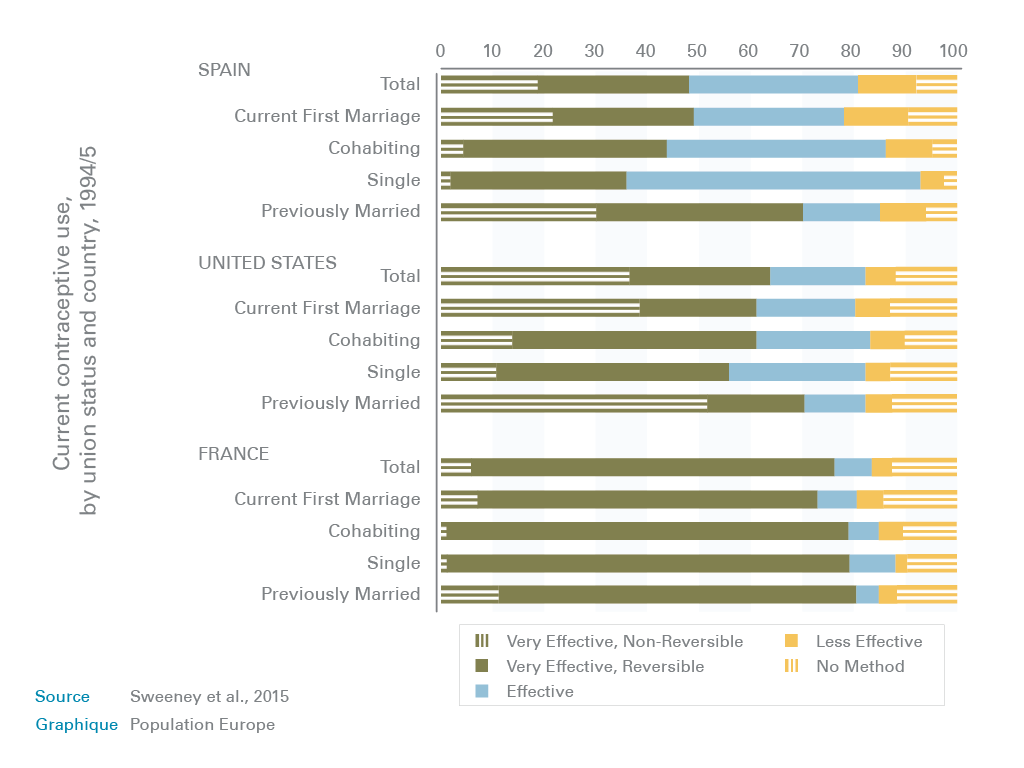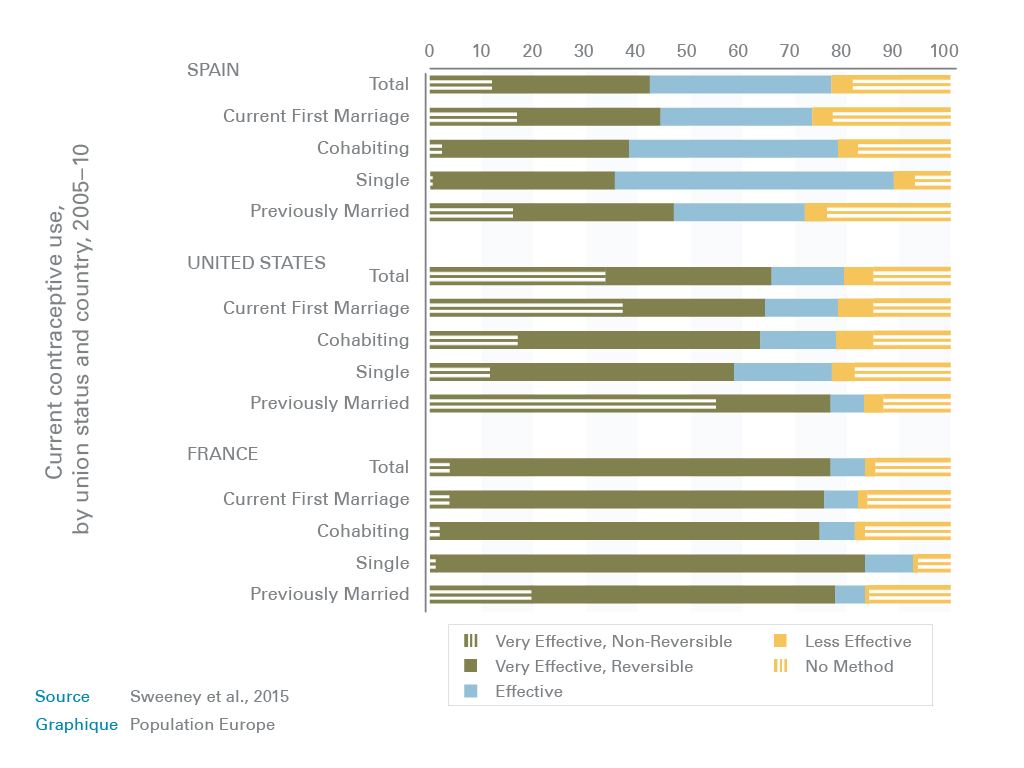Exploring the differences in the use of contraceptives between cohabiting and married couples is a good measure for possible differences in fertility patterns between the two groups. Yet, such studies are rare for contemporary Spain and France. Particularly little is known about contraceptive use patterns among cohabiting women in these countries. This analysis by Megan M. Sweeney, Teresa Castro-Martin and Melinda Mills sheds light on recent patterns among cohabiters in the United States, Spain and France and refutes the assumption that highly effective contraception is a necessary precursor for dramatic growth in cohabitation, as previous research suggested.
The authors address two sets of questions: First, they ask whether cohabiting women differ from married women in the likelihood of using the most effective and reversible methods of contraception. Second, they explore whether the answers to these questions have changed since the mid-1990s, indicating that the reproductive context of cohabitation may have shifted over time.
The cross-sectional analysis is based on data from the U.S. National Survey of Family Growth, the Spanish Fertility, Family and Values Survey, the French Gender and Generations Survey, and the Fertility and Family Surveys. The type of contraceptives are classified as “very effective, non-reversible” (female and male sterilisation), “very effective, reversible” (pill, IUD, other hormonal methods), “effective” (diaphragm, female condom, male condom), “less effective” (periodic abstinence, withdrawal, and other methods), and “no method” (seeking pregnancy, other reasons). Union status is classified into four categories: cohabiting – never married, currently married – first marriage, single – never married, and any previous marriage. To maximise comparability across the multiple data sources, the authors limit all analytic samples to women aged 20 to 44 years, and exclude women who are not at risk of pregnancy for reasons other than surgical sterilisation (e.g., who were pregnant or postpartum, did not have a current sexual/intimate relationship, or were non-surgically sterile).
Changes and similarities over time
In the mid-1990s, overall usage of “very effective” contraceptive methods (includes reversible and non-reversible) was very similar in the US and Spain for cohabiting and married women, and slightly more common among cohabiting women in France. When looking at non-reversible methods, large differences were observed between married and cohabiting women in all three countries, with sterilisation being considerably more common among married than cohabiting women.

In the late-2000s, overall use of the most effective methods (combined reversible and non-reversible “very effective” methods) declined among all Spanish women (from 48 to 42%), but remained stable or even increased slightly among American and French women. In the United States, use of the most effective contraceptives remained similar for cohabiting and married women in both time periods. Only in France is there evidence of increasing resemblance between cohabiting and married women over time in the use of the most effective contraceptive methods. With respect to irreversibility of methods used, however, married women continue to be more likely than cohabiting women to rely on male or female sterilisation in all three countries in the later period.

The U.S. as an exception
These descriptive results showing no significant differences for cohabiting and married women in Spain during the 1995 and 2006?10 time period were confirmed by the multivariate analysis, which adjusted for differences in age and parity distributions. When looking at differences between cohabiting and married women, however, cohabiting women in the U.S. were significantly more likely than married women to use “very effective” contraceptive methods. Consistent with the previous descriptive results for France, a statistically significant difference between cohabiting women and married women in the mid-1990s was found, with cohabiters being more likely to use “very effective” contraception. However, the difference between cohabiting and married women in France was no longer statistically significant by 2005.
The authors expected to find differences in contraceptive use between married versus cohabiting women to change the most over time in Spain, where the prevalence of cohabitation had experienced the most dramatic growth. Instead, their results suggest remarkable consistency over time. Even when cohabitation was statistically uncommon in Spain, the contraceptive behaviour of cohabiting women resembled that of married women. In contrast, the data for France showed some evidence of growth over time in the resemblance of contraceptive use between both groups.
The extent to which cohabiting and married women are likely to choose a reversible contraceptive was found relatively stable over time, conditional on using a very effective method. In Spain and France, these differences are no longer significant after adjusting for compositional differences between these groups. In the United States, however, differences in the likelihood of selecting a reversible method persist after introducing controls for age, parity, education and school enrolment.
Contraceptives don’t necessarily increase cohabitation
Many family scholars argue that the rise of cohabitation was fuelled by the widespread availability of highly effective, reversible contraceptive methods, such as the birth control pill. If true, this would suggest that in times and places where cohabitation offers a less acceptable context for childbearing than marriage, rates of highly-effective contraceptive use should be higher among cohabiting than married women after adjusting for other compositional differences between the two groups. These results indicate that while this may have been true in the United States and France, it seems unlikely to apply to Spain. Reliance on the male condom has remained the most common method of contraception among Spanish cohabiters during the entire time span covered by this study, with no significant differences between married and cohabiting women in use of the most effective methods.

*This PopDigest has received funding from the European Union's Seventh Framework Programme (FP7/2007-2013) under grant agreement n° 320116 for the research project FamiliesAndSocieties.
FamiliesAndSocieties (www.familiesandsocieties.eu) has the aim to investigate the diversity of family forms, relationships and life courses in Europe, to assess the compatibility of existing policies with these changes, and to contribute to evidence-based policy-making. The consortium brings together 25 leading universities and research institutes in 15 European countries and three transnational civil society organizations.